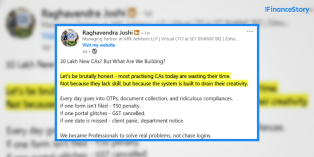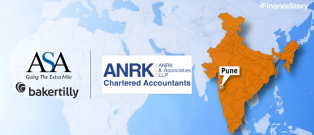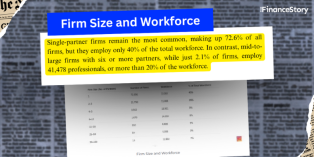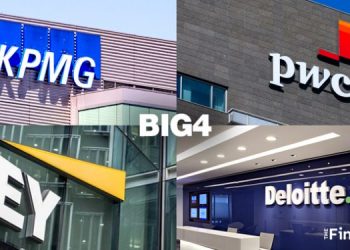- Hi, I’m Nehal Sheth. In 2021, after 13 long years, I quit EY as an Associate Partner to start a boutique tax & advisory firm.
- Today, we’re a 50+ member team in Ahmedabad, advising top businesses at Big 4-level fees—sometimes even higher.
- And with GIFT City, Gujarat’s GCC, and the IPO boom, the market is exploding.
- Thinking of making the leap? The opportunity is huge, and clients are lining up.
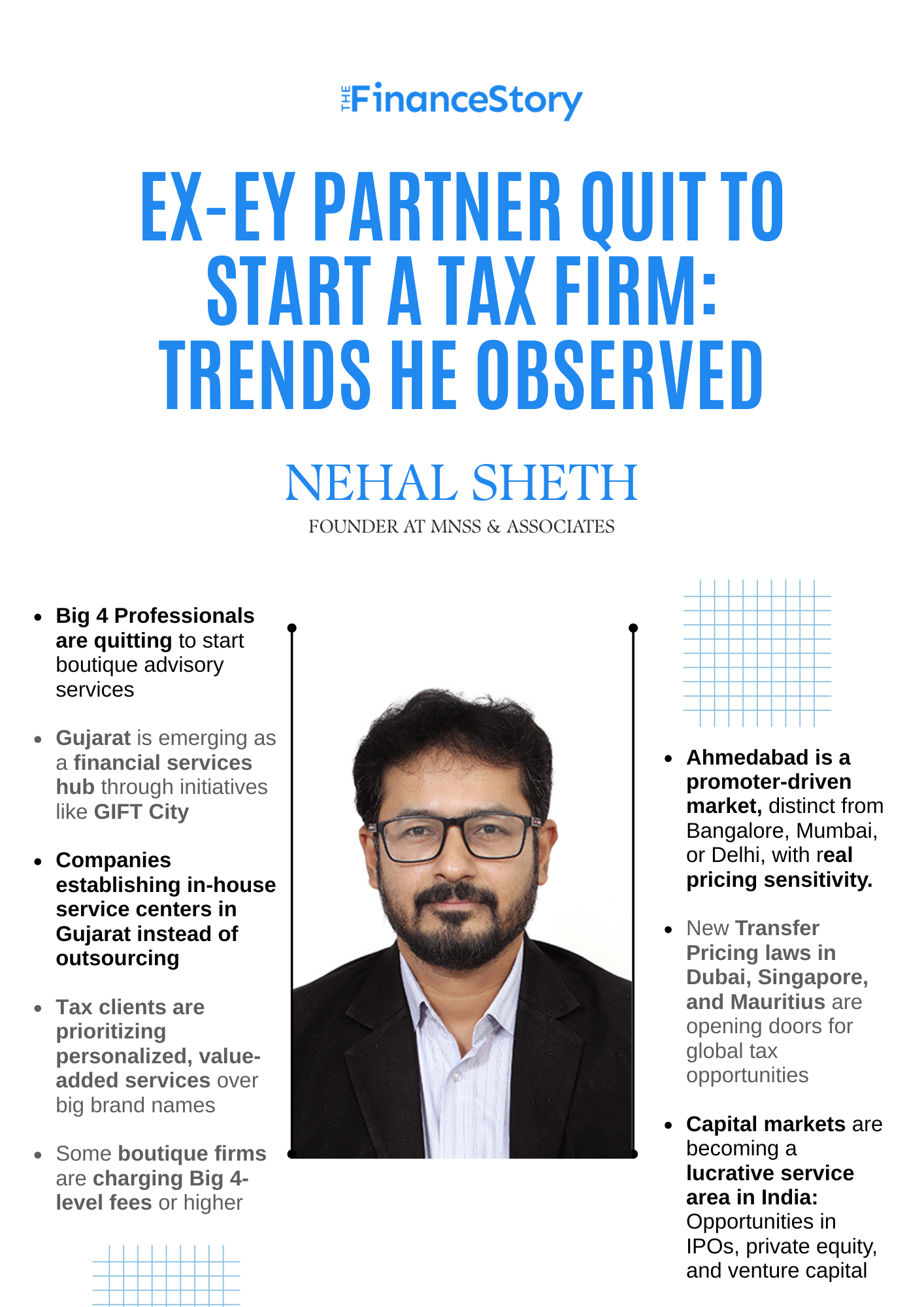
Why I quit as EY Partner to start my own
My career started 17 years ago when I joined RSM as a fresher.
- In 2007, RSM merged with PwC.
- In 2008, I moved to EY—just two months after they set up their tax practice in Ahmedabad.
- Fast forward 14 years to 2021, EY had built a leading tax practice in Gujarat, and I was growing within the firm.
The prestige was there.
The career trajectory looked great.
But deep down, I kept asking myself: “Is this what I want long-term?”
After some deep thinking, the answer became clear—I wanted to build something of my own. A firm that was different from the Big 4.
There were doubts. A lot of doubts.
Will clients still trust me without EY behind me?
Will I be able to build something sustainable?
But I also knew this: if I didn’t leap now, I might never do it.
So, despite the nerves, I went for it.
And in April 2021—right in the middle of COVID-19’s second wave—we launched MNSS (named after Mrunal and Nehal, my co-founder and me).
Starting out
Capital…
When we started, we had savings from our careers and were more than willing to put in significant capital.
In fact, beyond the initial three months, we never really needed to put in more capital.
Fortunately, we turned profitable in year 1.
By Year 2, we had already surpassed all our projections.
The legacy we carried as Partners gave us an edge, allowing us to scale efficiently.
No revenue targets
One of the biggest reasons I left the Big 4? I didn’t want my work to be dictated by billing numbers.
The moment everything is tied to revenue targets, your mindset shifts.
So we built a firm where value—not revenue—drives decisions. And ironically? That’s exactly what made us more successful.
Dedicate almost 100% of their time to delivering value-added services
In large consulting firms, I noticed that nearly 30-40% of time was spent on MIS and data reporting.
Teams were constantly preparing reports for business heads, reviewing risk procedures, and engaging in activities that didn’t directly add value to clients.
This meant that only 50-60% of time was truly productive.
We structured our organization around clients and people.
High-quality team
Our team isn’t just built for scale—it’s built for quality. We brought in:
- Qualified CAs who think beyond compliance
- Ex-Big 4 professionals who know what works (and what doesn’t)
- Talent relocating from Delhi, Mumbai, and Bangalore—because Ahmedabad is now a serious career destination
We also ditched the rigid hierarchy. Instead of 6-7 layers of approvals, we have just three levels below partners.
Fees?
Our fees? On par with the Big 4 and other consulting firms! Sometimes, we even charge more.
Why? Because:
- Partners and senior team members are deeply involved in every assignment.
- We don’t just “sell”we execute.
- Significant partner time is spent on each engagement.
Talking specifically about Ahmedabad, it is a promoter-driven market.
It is a very different market from what you would probably see in Bangalore, Mumbai or Delhi. And pricing sensitivity is real.
Here, you need to justify every rupee.
Clients won’t pay you just because you spent 50 hours on an assignment. They care about results (and rightly so!)
They’ll ask: “What’s the out-of-the-box solution you’re bringing? Why should I choose you over another big firm?”
But once clients see the value, they will not question your fees.
I’ve rarely faced pushback on pricing because the results speak for themselves.
Also read: Quit Deloitte to join mid-sized firm; now Co-CEO with 1700+ team, clients in 50+ countries
How did we acquire clients?
Honestly, when I left EY, I wondered, “Will clients trust me without the EY brand?”
Turns out, relationships matter more than a logo.
Unlike audit, where a Big 4 brand name is crucial, tax clients prioritize expertise and trust over branding.
When I told my clients and mentors about my plan, some of them immediately said,
“Nehal, I want to be your first client. Send me an engagement letter—put in any number you want. I just want to support you.”
- We never did aggressive marketing
- We didn’t cold-pitch
- We just focused on delivering value, and most of our business has come through word-of-mouth
And still, demand has always outpaced supply for us.
It is very important to note that when you move out on your own you have to be more proactive.
We have to bring in our own business and manage our clients.
The Ahmedabad advantage: How Gujarat is changing
Ahmedabad has traditionally been an industrial hub, but that’s changing fast. Two major developments are shaping the financial landscape:
GIFT City: India’s emerging financial hub
Previously, if a company wanted to set up a BPO, KPO, or offshoring center, they would go to Bangalore, Pune, Hyderabad, or Delhi-Gurgaon.
But with GIFT City, we now have a financial services hub right here.
My global clients now discuss whether they want to invest in India via Dubai, Singapore, the US, or the Cayman Islands. And now, there’s one more option on the table: Should we invest in GIFT City?
A lot of the funds we have successfully set up over the last 3-4 years have been driven by the presence of GIFT City.
With government support, regulatory incentives, and tax benefits, significant business growth is in the horizon for Gujarat moving forward.
Gujarat’s GCC Policy
Earlier, European and US companies outsourced work to Indian IT firms like Infosys and TCS. Now, they’re setting up their own Global Capability Centers (GCCs).
Thanks to Gujarat’s GCC policy. It is extremely lucrative for us.
Some of our largest clients have started streamlining their supply chains to explore these opportunities.
For example, if a group operates across 10 industries with 50 companies, why not consolidate everything into one center? A shared service center within a GCC could serve all 10 industries.
This brings a huge cost advantage for them.
We’re working with clients to:
- Structure their GCC frameworks
- Leverage tax incentives
- Optimize payroll costs
New areas of practice
While we’ve remained clear on our high-value, boutique approach, we see exciting opportunities in:
Transfer Pricing in Dubai and Mauritius
- These regions recently introduced transfer pricing regulations, and many advisors there are still catching up.
- Clients are seeking our expertise to navigate these new laws.
India’s expanding capital markets
- The entire economy is shifting toward financial investments.
- This is creating a huge opportunity for corporations to raise funds through various capital-raising mechanisms—whether it’s private capital, venture capital, or IPOs.
- We see significant potential in advising firms through these transitions.
- The last 2-3 years have been strong, and I believe this cycle will continue.
Also read: EY Director quit on spotting new & bigger opportunities outside Big 4
The biggest challenge isn’t getting clients…
It’s finding the right people with the expertise, mindset, and cultural fit for a consulting firm like ours.
One thing holding us back from scaling faster it’s talent.
Interestingly, even Big 4 firms are struggling with this.
But our attrition rate is super low.
We want to be the most admired firm, one that people aspire to work for.
Wrapping up…
Boutique firms are now competing at Big 4 pricing.
They charge Big 4 fees (or more!) while offering deeper expertise, faster decisions, and real value.
The consulting game is changing. It’s no longer about the biggest brand; it’s about the biggest impact.
It is important to note that leaving a Big 4 firm means losing its network, brand, and alliances.
At EY, work landed in my inbox, pre-approved and pre-negotiated.
Running a firm? Completely different ballgame. I have to find business, build trust, and manage everything.
But it’s been worth it.





